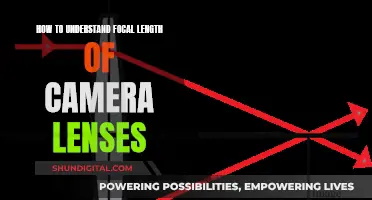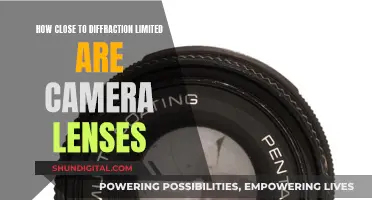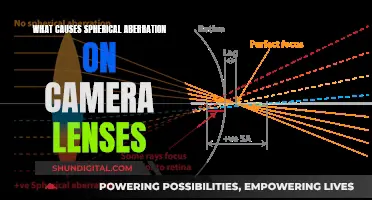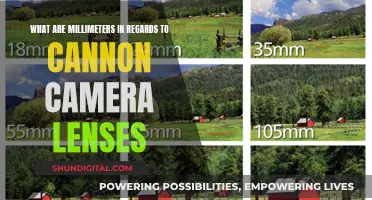
There are two main types of camera lens: zoom and prime. Zoom lenses have variable focal lengths, allowing you to change your composition by zooming in and out. Prime lenses have a fixed focal length, meaning you can't zoom in or out. Instead, you must move closer to or further away from your subject.
Prime lenses are often sharper, smaller, lighter, and cheaper than zoom lenses. However, zoom lenses offer greater versatility and flexibility, allowing you to control your shot without changing your vantage point.
Within these two categories, there are several other types of lenses:
- Standard lenses have a mid-range focal length, typically between 40mm and 60mm, offering a natural field of view similar to the human eye.
- Telephoto lenses have a longer focal length, usually above 60mm, and can be further categorised into mid-range (70mm to 200mm) and super-telephoto (over 200mm). They are ideal for portrait, wildlife, and sports photography, as they allow you to capture subjects from a distance.
- Wide-angle lenses have a shorter focal length, typically below 40mm, offering a wider field of view than standard lenses. They are commonly used in landscape, architecture, and real estate photography, as they capture more of the scene.
- Ultra-wide-angle lenses provide an even wider view than wide-angle lenses, typically with a focal length shorter than 24mm on a full-frame camera.
- Super-zoom lenses offer a wider range than standard zoom lenses but often compromise on image quality.
- Macro lenses are designed for close-up photography, with a 1:1 ratio, allowing you to capture small subjects in detail.
- Fisheye lenses are a type of ultra-wide-angle lens that creates an extreme wide-angle effect, similar to a GoPro image.
- Tilt-shift lenses allow you to distort and change the perspective of a shot by manipulating the focal plane. They are often used in architectural photography to ensure buildings appear straight and vertical.
What You'll Learn
- Prime lenses have a fixed focal length and are good for portraits and landscapes
- Zoom lenses have a variable focal length and are versatile, but can be heavy and expensive
- Telephoto lenses are good for wildlife and sports photography, as they allow you to get close to faraway subjects
- Wide-angle lenses are great for landscape and real estate photography, as they offer a wide field of vision
- Macro lenses are used for extreme close-ups and are ideal for product photography and capturing small subjects

Prime lenses have a fixed focal length and are good for portraits and landscapes
Prime lenses are a classic style of camera lens that have been around for as long as cameras have. They are one of the two main types of camera lens, the other being zoom lenses.
Prime lenses have a fixed focal length, meaning that you cannot zoom in or out. This means that they are less versatile than zoom lenses, but they do offer other benefits. For example, they often have wider maximum apertures, allowing more light in and making them ideal for low-light settings. They also tend to be lighter, cheaper, and produce higher-quality images than zoom lenses.
The 50mm prime lens, also known as the "Nifty Fifty", is a popular choice for portraits as the focal length is considered to be as close to the human eye as possible. A 35mm prime lens, on the other hand, is usually best for landscape photography.
Prime lenses are great for portraits and landscapes as they allow you to get creative with your compositions. They also often have a shallow depth of field, allowing you to achieve a beautiful bokeh effect and blur out the background.
When using a prime lens for landscapes, it's important to consider the focal length you'll need for the specific scene you want to capture. A wide-angle lens, typically between 14mm and 35mm, is ideal for capturing vast and dynamic landscapes. It allows you to capture more of the scenery and create a vivid picture. A 35mm lens, for example, is a happy medium that allows you to get wide shots while still retaining foreground and background details.
For more intimate landscapes or those with a specific focus, a longer focal length may be preferred. A 50mm lens, for instance, can be great for capturing compelling images from a single location, as you'll need to move around and get creative with your compositions.
Prime lenses for landscapes can range from wide-angle lenses like the Sony 14mm f/1.8 G Master to longer focal lengths like the Sony 135mm f/1.8 G Master, which allows you to focus on specific parts of the landscape.
In summary, prime lenses are a great choice for portrait and landscape photography due to their fixed focal length, wide apertures, and ability to produce high-quality images. By choosing the right focal length for your specific needs, you can capture stunning portraits and landscapes with creative compositions and beautiful bokeh effects.
Understanding Camera Lenses: Long Focal Points Explained
You may want to see also

Zoom lenses have a variable focal length and are versatile, but can be heavy and expensive
Zoom lenses are highly versatile and a must-have in your photography kit. They offer a wide range of focal lengths, allowing you to capture anything from street photography to wildlife with a single lens. For example, with a 70-200mm zoom lens, you can easily zoom from 70mm to 200mm without changing lenses. This versatility is especially useful when travelling light or when you need to adapt to diverse shooting scenarios. Zoom lenses are also ideal for wedding photography, with the 70-200mm lens being a popular choice for wedding photographers.
However, one of the main drawbacks of zoom lenses is their weight. Longer zoom lenses, such as those in the super-telephoto range (above 300mm), can be quite heavy and bulky, often requiring a tripod for support. This makes them less practical for travel or situations where mobility is important. Additionally, zoom lenses tend to be more expensive than prime lenses. They can also be heavier and have smaller maximum apertures, which may be a consideration for low-light photography.
Despite these drawbacks, zoom lenses remain a popular choice due to their versatility and adaptability. They are ideal for photographers who need to quickly adapt to different shooting situations without having to change lenses frequently. With a zoom lens, you can control your shot more effectively without needing to change your vantage point.
Leica Lenses: Panasonic Cameras' Secret Weapon?
You may want to see also

Telephoto lenses are good for wildlife and sports photography, as they allow you to get close to faraway subjects
Telephoto lenses are a type of camera lens that is perfect for wildlife and sports photography. They have a focal length of more than 60mm, with “short telephotos” ranging from 85 to 135mm, and “super telephotos” starting at 300mm. These lenses allow photographers to capture faraway subjects in great detail, making them ideal for photographing wildlife or sports events from a distance.
One of the key advantages of telephoto lenses is their incredible magnification power. They contain multiple glass elements, similar to a telescope, allowing photographers to get close-up shots of distant objects. This makes them particularly useful for wildlife photographers who want to capture intimate images of animals without disturbing them or putting themselves in harm's way. Similarly, sports photographers can capture action shots from the sidelines without having to step onto the playing field.
Telephoto lenses also offer a narrow angle of view, which can be advantageous for isolating a subject and creating a compressed, two-dimensional look. This effect is often desired in portrait photography, as it can slim down the face slightly and provide a pleasing background blur, making the subject stand out. Additionally, telephoto lenses have smaller maximum apertures, which can be beneficial for achieving a shallow depth of field and creating a soft background.
While telephoto lenses excel in certain situations, they do have some drawbacks. As the focal length increases, so do the weight and size of the lens. Super-telephoto lenses can be quite bulky and heavy, often requiring the use of a tripod for stability. This makes them less ideal for walk-around photography or situations where mobility is important. Additionally, telephoto lenses can be more challenging to frame subjects, especially when compared to wider lenses.
In conclusion, telephoto lenses are a valuable tool for photographers, especially those specialising in wildlife and sports photography. They provide the ability to capture distant subjects with excellent magnification and a narrow angle of view, resulting in stunning images that would be difficult to achieve with other types of lenses.
Camera Lens Cleaning: To DIY or to Outsource?
You may want to see also

Wide-angle lenses are great for landscape and real estate photography, as they offer a wide field of vision
Wide-angle lenses are a must-have for landscape photographers looking to elevate their craft. They offer a wider focal field, allowing photographers to capture more of the scene in front of them than with a zoom lens. This makes them perfect for capturing landscapes, as you can capture more of the scenery and create a much more vivid picture.
Wide-angle lenses are also ideal for real estate photography, as they allow you to capture the entire building without having to move too far away. This is especially valuable for interior real estate photography, as you can photograph entire rooms from the inside.
The focal length of a wide-angle lens typically falls between 14mm and 35mm, although some sources state that anything below 40mm can be considered a wide-angle lens. These lenses offer a wide field of vision, with a broad scope from side to side, making them more panoramic than a standard lens.
When choosing a wide-angle lens, you can opt for either a prime or a zoom lens. Prime lenses have a fixed focal length, while zoom lenses offer a variable focal length within a specific range. For example, with a 16-35mm zoom lens, you can adjust the focal point anywhere within that range.
It's worth noting that while wide-angle lenses offer a broader field of view, they can also introduce distortion, making straight lines appear curved. This effect is more prominent in ultra-wide-angle lenses with a focal length of less than 14mm, often referred to as fisheye lenses.
In conclusion, wide-angle lenses are a valuable tool for landscape and real estate photographers due to their ability to capture expansive scenes and spaces. By understanding the characteristics and options available, photographers can make informed choices when selecting wide-angle lenses to enhance their craft.
The Art of Handling Camera Lenses: A Beginner's Guide
You may want to see also

Macro lenses are used for extreme close-ups and are ideal for product photography and capturing small subjects
Macro lenses are a type of camera lens that can focus on extremely close-up shots of minuscule objects, such as insects, flowers, water droplets, and other small subjects. They are ideal for product photography, especially for smaller products, as they can capture intricate details with a shallow depth of field, creating a pleasing bokeh effect.
Macro lenses are also excellent for newborn photography, allowing photographers to capture tiny details like eyelashes, fingers, and toes. They can also be used for portrait photography, as they have focal lengths suitable for portraits and can capture amazing detail even at very close distances.
When choosing a macro lens, it is important to consider the camera's sensor size, as this will impact the effective focal length of the lens. For example, a 60mm macro lens on a crop sensor camera will behave like a 90mm lens, resulting in a tighter crop and shallower depth of field.
Macro lenses typically have a magnification ratio of 1:1, meaning the subject will appear life-sized on the camera's sensor. Some macro lenses even exceed this ratio, offering greater-than-life-sized reproduction. The focal length of macro lenses can vary, but they are usually no shorter than 40-60mm to accommodate extremely close focusing distances.
While macro lenses are specialised gear with limited applications, they can be incredibly versatile. They can be used for nature, portraiture, food, and even landscape photography, offering artistic freedom and the ability to capture unique perspectives.
EF-S Lenses: Full-Frame Camera Compatibility Explored
You may want to see also
Frequently asked questions
The two main types of camera lenses are prime and zoom. Prime lenses have a fixed focal length and are often sharper, smaller, lighter, and cheaper. Zoom lenses have a variable focal length, offering more flexibility but are usually heavier and more expensive.
A standard lens typically has a focal length between 40mm and 60mm, with 50mm being the most common. This focal length provides a field of view similar to the human eye, making it a versatile choice for various photography types, including landscape, portrait, and street photography.
A telephoto lens has a focal length above 60mm, with lenses over 200mm considered "super-telephoto". These lenses magnify distant subjects and are ideal for wildlife, sports, and portrait photography. They create a flattering background blur, making the subject "pop" from the background.
A wide-angle lens is the opposite of a telephoto lens, with a focal length below 40mm. It allows you to capture more of the scene, but it can also introduce distortion. Wide-angle lenses are great for cramped interiors, large group shots, and landscape photography.
A macro lens is designed for close-up photography, with a 1:1 ratio, meaning it can capture subjects at life-size magnification. They are excellent for capturing tiny details and are often used for product photography, macro photography, and even portraits, as they produce beautiful bokeh.







